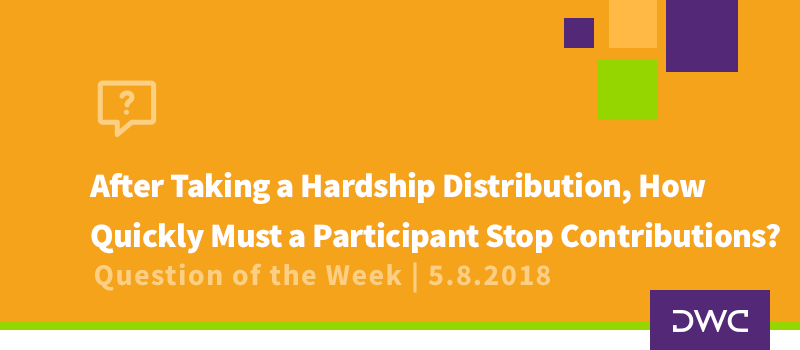
Plan Eligibility
Companies that sponsor retirement plans have a great deal of flexibility in determining who is eligible for those plans. However, since plans are always required to follow the terms outlined in their plan documents, companies should plan to ensure the eligibility provisions clearly reflect their intentions.
Some of the variables we can work with to come up with just the right provisions are as follows:
- Identifying which class(es) of employees should be included and which should be excluded,
- Setting a minimum age requirement,
- Establishing the waiting period before new employees join the plan (including a method for counting service during that waiting period), and
- Defining set dates on which eligible employees actually enter the plan.
Let’s explore these variables in turn.
Excluding Employees
While expanding retirement plan coverage to as many employees as possible is generally a good thing from a public policy perspective, there are plenty of business reasons that a company might want to carve out certain classes of workers. A plan can exclude certain groups without triggering other requirements. These include non-resident aliens as well as union employees whose retirement benefits are subject to collective bargaining. Beyond that, the general rule is that a plan can exclude up to 30% of its non-highly compensated employees and still satisfy the annually required minimum coverage test; however, there are some limitations to keep in mind.
The first step is to correctly identify which workers are employees and which are independent contractors. The second is to ensure employees are properly and clearly classified in such a way that reflects the company’s intentions. Those two subjects are enough for a full article on their own. In fact, we have written one here, but we have included an overview below.
Independent Contractors
Company-sponsored retirement plans are required to be maintained for the exclusive benefit of employees, and independent contractors are not employees. As a result, it is not necessary to formally exclude them, because they are not allowed to be covered in the first place.
Determining who is an employee and who is a contractor can get a bit murky, though. In the 1990s, Microsoft classified a group of workers as independent contractors. Those workers observed that they were doing the same work as others who were classified as employees, but they weren’t getting all the same retirement benefits the employees received. They sued for those benefits, and Microsoft defended itself by pointing out that the plan document specifically excluded independent contractors. While the court agreed that the exclusion was in place, it ruled that the workers in question were not actually contractors but common law employees; therefore, they did not fall under the documented exclusion. Microsoft was ordered to pay nearly $100 million in back benefits.
As a result of that case, most (if not all) plan documents now include language that excludes workers classified as independent contractors on the payroll records of the company. This more precise exclusion takes the determination out of the realm of the legal definition and ties it to how the particular company classifies its workers.
If you want to go further down this rabbit hole, the name of the case is Vizcaino v. Microsoft Corporation.
Less Than Full Time
Many businesses employ part time workers, and schedules can vary quite a bit. Other variations of part time workers are seasonal employees, temporary employees, per diem employees, etc. The one thing all of these types of workers have in common is that they are still employees whose eligibility for benefits is based on plan terms. That means it’s not enough to just operationally exclude them; plan language must be added to accomplish that result.
Excluding part-timers can be a tricky proposition. The reason is that there are rules that set the maximum period a company can make employees wait before joining a retirement plan. We’ll get into more detail on that in a minute, but the gist is that the longest allowable waiting period is one year of service. In 2006, the IRS published a Quality Assurance Bulletin (QAB) that says excluding part-time employees, seasonal employees, et. al. is really an end-run around the maximum waiting period rule in that it completely excludes them based on the amount that they work.
So, how do we solve that problem? By excluding those workers based on some other factor of their employment, such as their job responsibilities. Here is an example:
Shady Oaks Golf Club employs a group of seasonal employees it wants to exclude from its 401(k) plan. Based on the 2006 QAB, doing so based on their classification as “seasonal” would be a violation. Shady Oaks happens to be in Northern New England, the fact that snow has the golf course covered for 6 months out of the year is the reason all the groundskeepers are only employed seasonally. Eureka! If we write the 401(k) plan to exclude groundskeepers, we are on the correct side of the QAB, because the exclusion is based on the type of work rather than the amount.
Other Classifications
There are plenty of other valid business classifications that a company might use for any number of purposes, and many of them can also be used in a plan document to exclude groups of workers. Remember, precise plan document wording is critical even if it seems pretty clear-cut. Here are a couple of examples:
- Work Location: A plan could exclude all employees who work in the company’s San Francisco office. But what happens if one of those employees transfers to the Boston office for a month? What about 6 months or a year? Does that previously excluded worker now join the plan? If so, how long being away from the San Francisco office is long enough? What if s/he moves back to San Francisco at a later date? To make matters more confusing, what if that individual moves back to the west coast but works from home rather than actually going into the office?
- Students: Maybe the plan excludes students. Does that mean all students or just undergraduates? What about part-time students who work full time? What about the company’s CFO who decides to take night classes to pursue an MBA? What about an employee who takes a random photography class at a local community college? All of those are students…should they all be excluded?
Plan sponsors must carefully consider these nuances. Since ambiguity in plan terms is usually going to be interpreted in the light most favorable to the participants, it is important that plan language clearly articulates the intent.
Minimum Age Requirement
A plan can, but is not required, to set an age requirement. There isn’t too much to say about this one other than the fact the maximum allowable age requirement is attainment of age 21.
Although straight-forward, the age requirement can be used to exclude certain groups of employees. Going back to our example at Shady Oaks Golf Club, if all of the seasonal employees are high school students, they could excluded by simply setting the age requirement at 21.
Once the decision is made, the age requirement must be reflected in the plan document.
Waiting Period
The longest waiting period that a 401(k) plan can utilize is one year of service, which is defined as a 12-month “eligibility computation period” in which an employee works at least 1,000 hours. It is important to note that when a plan uses that maximum requirement, an employee must satisfy both prongs – 12 months and 1,000 hours – to meet the requirement. In other words, an employee who is hired in January reaches 1,000 hours in June still hasn’t satisfied one year of service until s/he has also been employed for a full 12 months. Plans can apply shorter waiting periods, but they cannot be more restrictive.
So what are some of the deciding factors? If a company has high turnover in the first year, sticking to the maximum requirements might make sense. If a company wants to enroll new employees right away, requiring only one month of service might be the way to go.
Again, the plan document must reflect the waiting period that will apply, and the provisions must then be applied consistently. However, this is not necessarily a “set it and forget about it” item. Consider a company that has all full-time employees and sets the waiting period at one month. Fast forward a couple years, and the company hires summer interns and part-time employees. Based on the one-month requirement, those interns and part-timers join the plan after only a month unless the company amends the plan ahead of time to apply a longer waiting period for new hires.
Speaking of a one-month waiting period, this is another area where it pays to be clear with intentions. Does one month mean an employee meets the requirement on the one-month anniversary of his/her date of hire? Or does one month mean 30 days or 31 days or 28 days (for February)? What about leap year? These questions might seem silly and nitpicky, but they come up more frequently than you might guess. Any of those options are fine, but it is still critical that the plan document clearly state the intent.
What about rehires? Regulations require that service be combined for employees who are terminated and rehired within certain timeframes. If one of Shady Oaks’ employees works during winter break, spring break, and summer vacation all in the same year, service during all three of those stints is combined to determine whether the waiting period is satisfied.
There are all sorts of additional rules that can come into play when measuring service for eligibility, and we describe them here. We also provide more details on dealing with rehires here.
Long-Term, Part-Time Employees
There is an important exception to 1 year of service being the maximum allowable waiting period. The SECURE Act (enacted December 2019) and SECURE 2.0 (enacted December 2022) created new rules for so-called “long-term, part-time” employees of companies that sponsor 401(k) and 403(b) plans. We go into some detail on those new rules here, but here is the TL;DR…any employee who works at least 500 hours per year in two consecutive years must be allowed to join the plan for salary deferral purposes only. A plan sponsor can optionally extend that to also include company contributions, but the requirement only applies to deferrals.
Plan Entry Dates
Now that an employee has met the age requirement and completed the waiting period, the plan entry date is the day s/he actually joins the plan. The plan can specify that entry dates are every day, the first of each month, quarter, etc. Just like the age and service requirements, plan entry dates must be reflected in the plan document and applied consistently.
Entry dates are fairly straight-forward, but there are a couple nuances worth noting. First is the identification of which entry date to use. Most plans say that an employee enters the plan on the entry date coincident with or next following satisfaction of the age and service conditions. That means if a new hire satisfies age and service exactly on an entry date, that employee joins the plan that day. However, some plans are written to say that an employee joins the plan on the first entry date after meeting age and service. It’s a subtle difference but one that can be important.
The second nuance is that, as a general rule, the combination of waiting period and entry dates cannot cause an employee to wait more than 18 months to join the plan. So, a plan that sets is waiting period at one year must have at least semi-annual entry dates (January 1 and July 1 for a calendar year plan). On the other hand, a plan that only requires a six-month wait could have only a single plan entry date on the first day of each year. In practice, we find that many plans will set their entry dates at either semi-annual, quarterly, or monthly.
One word of administrative caution is in order. It can be tempting to allow employees to join the plan as soon as they satisfy the age and service requirements, effectively making every day an entry date. There is nothing wrong with that; however, if a company is doing a lot of hiring, daily entry dates can mean someone is constantly helping newly eligible employees get enrolled. For that reason, instead of using a one-month waiting period and daily entry dates, it might be less administratively burdensome to instead eliminate the waiting period altogether and have monthly entry dates. Employees are generally joining the plan within a similar timeframe, but you are only dealing with enrollments once per month rather than potentially every day.
Mix And Match
As if there wasn’t enough information to digest already, it is possible to use different eligibility criteria for different purposes. Perhaps, you want to allow salaried employees to join the plan right away but apply a one-year waiting period for hourly employees. No problem. What about allowing employees to defer from their own paychecks right away but making them wait for a year to share in company match or profit sharing contributions? Yep. Back to our friends with offices in San Francisco and Boston, Boston could be eligible right away and San Francisco after 6 months.
Not to sound like a broken record, but (you guessed it) all of this must be written into the plan document and applied consistently. We should also reiterate that the more a plan mixes and matches, the more time and attention are required to get it right. And the maximums we mentioned above (age 21, a year of service, and semi-annual entry dates) apply separately to each eligibility schedule. For example, it would not be ok to set the age at 19 for employee contributions and 23 for company contributions even though the average across the two is 21.
Conclusion
As you can see, there is quite a bit of flexibility available in setting a plan’s eligibility criteria. However, just because flexibility exists, doesn’t necessarily mean it should be used. In crafting any set of eligibility requirements, it is important to review the company’s internal resources (personnel, systems, etc.) to ensure that all relevant data can be tracked so that the rules can be properly and consistently applied and implemented timely. If you have questions about how to operate your plan’s eligibility rules or would like to discuss other options, hit us up. For more information on retirement plan design, visit our Knowledge Center here.


















